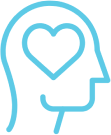Summary
- Maintaining eye health and quality of life are essential to one’s overall well-being.
- It is suggested by doctors to undergo a routine eye exam at least once a year.
- There are several different eye exams to test and gauge the strength and health of your eyes.
An eye exam, or eye test, is a diagnostic examination conducted by a medical professional – commonly an ophthalmologist, optometrist, or orthoptist – to gauge the strength and health of your eyes. However, eye exams go beyond testing our vision; they allow doctors to see if there are underlying neurological issues like developing blood clots.
Going to any doctor’s office can be intimidating, especially if you do not know what to expect. This blog post explores the most common types of eye exams performed.
Types of eye exams
There are many different types of eye exams, based on the type of examination needed. However, getting an annual comprehensive eye exam is vital to maintain your eye health and overall well-being.
Visual Acuity
The most basic and standard eye test is the Snellen Test, which examines visual acuity, or how far you can see. The Snellen Test is when you read alphabet letters from a piece of paper, and the letters get smaller as you read down the list. You have probably seen this in your doctor or school nurse’s office.
Visual Refraction
A visual refraction test includes looking at a Snellen or eye chart while looking through lenses. The doctor will quickly change the power of the lens and ask if you see more or less clearly.
Visual Field Test
A visual field test measures your peripheral vision, which is what you can see off to the side when looking straight. The doctor will ask you to look straight while they bring a light or object into your peripheral field.
Slit Lamp
Another name for a microscope a doctor will use to magnify and examine your eyes. It shines a light beam into the eye, allowing the doctor to closely inspect the cornea, iris, and anterior chamber. This tool can diagnose cataracts, glaucoma, retinal detachment, macular degeneration, and other eye issues.
Tonometry
A device that sends a puff of air to your eye to test and measure the fluid pressure inside your eye. This test can help detect glaucoma.
Ophthalmoscopy
Also known as a fundoscopy, this exam entails a machine with light and lenses that allow the doctor to see and take a picture of behind your eye. This exam allows the doctor to check the retina, optic nerve, and blood vessels.
The importance of eye health
Regular eye exams are crucial for maintaining good eye health and preventing serious vision problems. Many eye conditions, such as cataracts, glaucoma, and macular degeneration, develop gradually and may not show symptoms in their early stages, making routine checkups essential for early detection and treatment.
According to the Cleveland Clinic, people with a higher risk of eye disease or vision issues may need more frequent eye exams. You might need more frequent eye exams if:
- You’re over age 60.
- You’re of Black or Hispanic descent.
- You have overweight or obesity (a BMI, or body mass index, of 30 or more).
- You have a health condition that can cause eye issues or vision loss, like diabetes.
- You have a family history of eye disease.
- You wear glasses or contact lenses.
- You have a history of eye surgery, an eye injury or previous eye damage from conditions like strokes.
Neglecting eye care can lead to worsening vision or even permanent blindness, especially if conditions go undiagnosed and untreated. Additionally, eye exams can detect other health issues, such as diabetes and high blood pressure, that may manifest in the eyes before other symptoms arise. Prioritizing eye health ensures not only clear vision but overall well-being.

Expanding access to eye health in sub-Saharan Africa
In many regions of the world, including sub-Saharan Africa, access to eye health services is limited. This obstacle can be due to insufficient infrastructure, staff, medical supplies, equipment, or medications. Many individuals and families, particularly in Mali, Africa, lack the financial means to schedule regular eye exams and only see a doctor or nurse when a medical problem has become debilitating or life-threatening.
Embrace Relief addresses global health inequalities and increases access to health and medical services in some of the world’s most under-resourced countries, including Mali, Kenya, and Uganda.
Today, you can sponsor a cataract surgery in Africa and give a struggling person the gift of sight for just $120. Any donation, no matter the size, will help us provide those in need with medical interventions, essential medications, and hope for a better tomorrow.
How You Can Help: The Gift of Sight
A simple cataract surgery, which costs only $120, can transform a life. With your support, our Embrace Relief’s health clinics can provide these surgeries to those in need, giving them the gift of sight and the opportunity for a better future. Here’s how your donation can make a difference:
- $120 Donation: Funds one complete cataract surgery, restoring sight to an individual in need.
- $240 Donation: Supports two surgeries, doubling the impact.
- $600 Donation: Helps five people regain their vision, enhancing their quality of life and ability to contribute to their communities.
Your donation can make a significant difference in the lives of those suffering from cataracts in Mali and Burkina Faso. For just $120, you can fund a cataract surgery and give someone the precious gift of sight.
Help us light up lives and drive away the darkness caused by cataracts. Donate now and be a part of this life-changing mission.





















